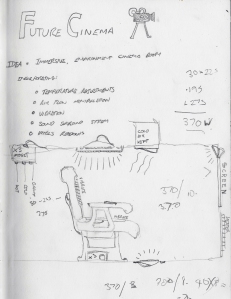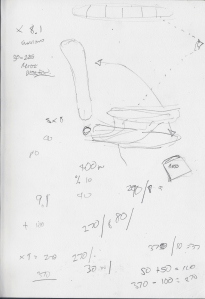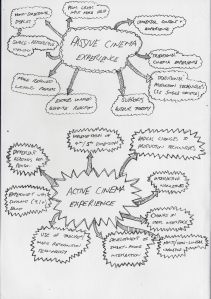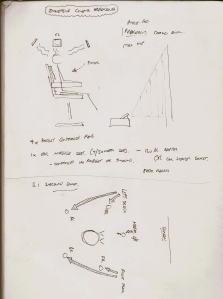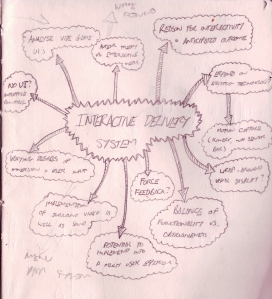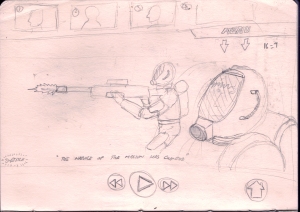Part of the beauty of the module was the sheer scope of what would be acceptable, perhaps even welcome, in the finished product, limited simply by budget and imagination. Or so I thought…
Category Archives: Future Cinema
The Death of the Cinema…?
Before we get started, pop this in your speakers. Ready? Then let’s begin.
We all remember the first time we went to an IMAX. We remember the dark, followed by the spectacle, the huge sound, the mind boggling 3D. And we all remember thinking “I say, this is ever so much better than the normal cinema back home.” And we remember going home, the images of 3D Star Wars or such rattling around our young minds, dreaming of one day making films that leap from the screens, or shook your seats.
10 years later, every cinema shows 3D screens, the sounds are bigger, the tickets more expensive, and I find myself facing the task of trying to supersede the aspects of cinema that seemed so groundbreaking in my childhood. People are used to 3D now. Surround sound is taken as read.
What else can we do to amaze people?
Several brave pioneers set sail on the Cinematic Sea, using computers and new pieces of equipment with names made of numbers and symbols. And what they gave us was interactivity. They made adverts that let us control what people did with our hands. They gave us trailer-games which the whole audience played as one. They gave us films that call us on our mobile phones.
It’s amazing what film can do these days, there’s no doubting that. I have no doubt that experiencing such a film would have a similar effect on any child today that 3D and surround sound did to me when I was young. But, much to my personal sadness, I’m not a kid anymore. I know what I like about Cinema, and I know what I don’t like about it; like people talking behind me, cracking jokes in scary films, or standing up in front of me. And all of this interactive malarkey, to me, seems just like that: distractions. Things that get in the way of the film.
Now don’t get me wrong: I’m all for advancing the concept of what film is, and experimenting with new technology, to different ends. But when I go to the cinema, more often than not, it’s to lose myself in a narrative, forget a day’s worries for a couple of hours, and maybe at most fail at trying to get closer to the girl I’m taking on a date….(jokes, I’ve never done that :P)
But all these frivolities and extras just feel like gimmicks to me; added features that mask a shoddily made film. Now, at this stage, that’s not the case, as these prototype films evidence extensive research, development and production value But think about future implications: if directors have to shoot dozens of alternative scenes and endings, they’ll put less effort into shooting and polishing each scene in order to make a film in a reasonable amount of time OR monstrously up the price of distribution, which will result in much more expensive cinema tickets. And either way, the audience loses out. Now, I’m pragmatic when it comes to film, and understand that films are ultimately about making money when it comes to the studio and much of the production team (accountants, studio heads, advertisers and reps) but forgetting that the audience is a discerning, at times idiotic, but definitely intelligent entity is a grave mistake. They will see past the shiny new toys, and realise that what;s underneath is poor. And they will be even angrier that they paid for it.
And they’ll be even angrier that they paid for some numpty in the front row to wave their arms around and influence the interactive narrative in ridiculous ways “for the lols.”
I’m not saying interactive cinema shouldn’t exist, far form it. But I fear for the survival of traditional auteur theory; the painstaking process of making a film that isn’t crap. The process that sorts true artists and decent directors form whiney men with berets and deck chairs.
Interactive Cinema and Traditional Cinema can co-exist. The old girl just needs to be brought up to speed a bit, which is what I set out to do. Cinema CAN be more immersive; you don’t need motion capture or mobile phones, it doesn’t NEED people to have to physically interact. And, in my opinion. the good folk at Secret Cinema got it right:
+MORE ON IT’S WAY, HOLD FAST+
The Thin Line between Success and Failure.
Unlike wiring a set of fans up to a volatile metal grid rig, or asking a girl on a date, there is rarely a simple “Yes or No” answer when it comes to ascertaining the success or failure of a project. The very fact that I’m writing this, less than 12 hours from when the projects in question are due in, should be an indication of the level of desperation these projects have developed, but, bizarrely, I’m the most relaxed I’ve been before a critique. EVER. Maybe it’s the fact all the heavy lifting, wiring and coding is done. Maybe it’s the beer. Maybe it’s the amphet-I MEAN *Coughs.* Regardless of whether it’s the quiet optimism of a man on the verge of success, or the gallows humour of a man accepting that he’s going to die tomorrow, this is a last ditch attempt to to explain, explore, and justify the two most challenging modules this course has thrown at me yet. So fill up your glass of wine, put on some Bach, and delve with me into the madness of Future Cinema and Performance Video.
Future Cinema and the Passive/Active Lemon Sponge.
With the step up to 2nd year/Level 5, it’s time to hit the ground running. First day back, and we get our first double brief: Future Cinema, and Building a UI. After the “freedom” of the last few projects, the lectures and frameworks of these projects have proven to be a bit of a shock, but at the same time, something of a refreshing change.
Especially with Building a UI, the world of MaxMSP and Processing coding language has opened up to us in all it’s bewildering glory. From the outset, I was pretty certain I was going to work towards the Future Cinema brief, although according to Deputy Head Lecturer Liam Birtles, the two flirt dangerously closely. An emphasis was placed on working in a pair with each person working towards both briefs, so that the UI and FC aspects could compliment each other. With that in mind, I agreed to revive the North/South Production duo with Rob Moore ( whose blog can be found here: http://rcmoore2.wordpress.com/)
Having worked with him on both the Principles of Computer Graphics AND Sound & Video Production briefs, I’ve found his working style and Artistic Vision to work well with mine, so it (hopefully) will be a good fit.
Our initial idea-generation hinged on an important issue: the Active/Passive Audience Experience divide. Much of the media we were shown focussed on the concept of varying degrees of audience interaction;
- Use of mobile phones in cinema to influence a multi-linear plot.
- Multiple-choice online videos.
- Mass-audience motion capture interaction.
However, as a consumer, I’m a fan of the passive cinema experience. While Active cinematic interaction seems to be a legitimate path that cinema could take, it will effectively shatter the idea of Auteur theory, and the idea of concise, revised writing, and in essence destroying the traditional film production technique. While I appreciate the right of people to engage in an Active Cinema, I myself do not see the appeal over traditional cinematic experiences.
With that in mind, I hoped to explore the envelope of PASSIVE entertainment. Going and sitting in a cinema/theatre and losing yourself in a piece is an experience I enjoy greatly; affecting an entire audience, leading them to experience the same/similar emotions and reactions, is a true artform.
It was at this point that Rob pointed out that his older brother Mike (who is now at Level 6/3rd Year) had worked on a 9.1 surround sound project for HIS Future Cinema one year previous. The piece proved to be highly effective (and slightly unnerving), and while limited to audio (the test subjects were blindfolded), it expanded greatly upon the fairly 1 dimensional audio that is prevalent in most cinemas: while the application of low end power and high definition is immeasurably superior to the home cinema experience, the utilisation of surround sound is fairly limited when considering the capability of technology we have at our disposal. This is the test reel of their project, which I think you’ll agree, is pretty spiffing.
The idea driving their project was a strong one, and while they explored the realms of sound to it’s fullest, they chose not to progress to the actual cinematic application of the technology. This would prove to be the core of our project.
Taking our seniors idea of immersive surround sound, we would then apply that to a physical Cinema setting, and expand upon it, using:
- Surround sound.
- Atmospheric manipulation (temperature, directional wind).
- Vibration.
While, for the sake of the time frame and the physical production of the piece, it would be best to make a mock-up for a single user, when I began designing the system, I considered how it would be incorporated into a tradition cinema setting (as I hoped to support the future of the traditional cinematic experience, rather than an interactive one).
As with our previous projects, we set our sights rather high, but as with most things, if you don’t shoot for the stars, the odds of taking off are slim. Here’s a taster of what’s to come:

